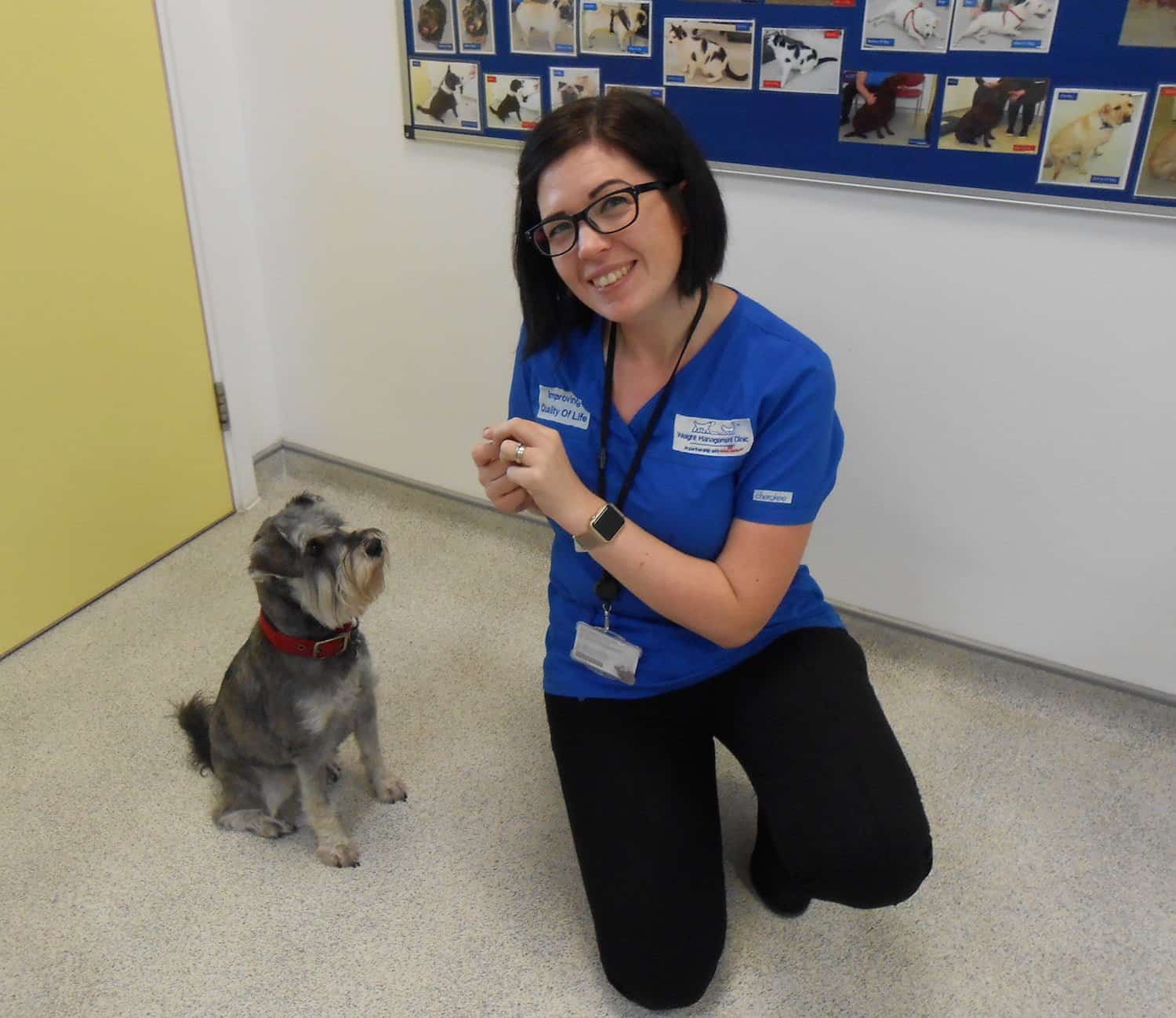Obesity is the number one medical concern for vets in the UK
A worrying 59 per cent of dogs, 39 per cent of cats and 30 per cent of growing dogs are overweight.
We spent a day at the Royal Canin Weight Management Clinic at Liverpool University with vet Alex German @TheFatVet and nurse Georgia Woods @TheFatVetNurse to discover what help is available.
Set up in 2005, it’s the world’s leading weight management centre, helping pets slim, raising awareness of the impact of obesity and researching to find a solution.
It’s tempting to treat our furry friends when they give us puppy dog or cute kitty eyes.
But obesity leads to arthritis, breathing difficulties, diabetes, urinary problems, poor quality of life and a shorter lifespan.
These things mean our pets can’t live their best lives – something we all strive to do
On average a dog at optimum weight will live for two years longer, and we all want our pets to be around as long as possible.
“We’re seeing animals who are three times their ideal weight,” says Georgia, who has two dogs, Visla Tigger, three, and Orla, a 12-year-old Golden Retriever and cats, Wicked, six, and Khaleesi, 15.
“It’s a sensitive issue. Pets are part of the family so when you talk about them being overweight, it’s similar to the parent/child parallel, but owners clearly love them and that’s why they come for help.
“No-one wants their pet to be overweight and at risk from the frightening diseases that go with it. We help pets reach a healthy weight and educate owners on how to maintain it.”
The clinic has helped more than 500 animals in 14 years – two-thirds dogs and a third cats. One, Golden Retriever Molly, spent five years getting to her target.

What happens when a pet visits the clinic?
The team see the most extreme cases from across the country. First, Georgia speaks to them on the phone and explains the process and sends forms out ahead of their visit.
Unlike a regular consultation which lasts around 15 minutes, Georgia and her colleagues spend four hours with the pets and their owners at the initial appointment.
They have a health MOT, discuss feeding and activity levels and are measured and photographed.
Alex takes blood and urine samples, monitors blood pressure and checks for other diseases that might be causing the pet weight gain and any other medical problems.
They have a DEXA (Dual-energy X-ray absorptiometry) scan which shows how much body fat and lean tissue or muscle mass is present.
“The scales only tell us the weight, not the proportion of body fat, or how overweight the patient is,” explains Alex.
“The DEXA scan allows us to know, very precisely, the dog or cat’s perfect weight. The diet is based on the weight they should weigh, not what they currently weigh.
“So we can create a plan that works first time to help them lose weight and give owners a target of what they should be aiming for.”
Alex explains how the DEXA scanner, which is only available at the Royal Canin clinic, works and shares a before and after scan of patient Molly the Staffie
The hard work begins when they return home
Ideally, pets return for check ups every two weeks and, on average, they spend nine months on their weight loss journey.
Support is key throughout the process and at the end, owners are armed with knowledge on how to keep their pet at a healthy weight for the rest of their life.
Georgia explains: “Building a relationship with the owners is really important. I want people to trust in my advice and be the person they turn to if there’s a problem.
“Sometimes they might have felt very bad about their pet’s weight up to this point and we try to turn this into a positive.
“They’re coming here to help their pet. It’s about moving forward and helping owners understand there are changes they can make.
“Measuring food on digital scales, cutting out treats, increasing exercise and using slow feeders and interactive toys all help. They don’t need to be expensive – you can make them out of loo rolls.”

Owners are encouraged by the many success stories including vet Alex’s cat Clarence
Alex’s late cat Clarence was a patient at the clinic and lost a quarter of his bodyweight, going from 8kg to 6kg.
He says: “His story helps reassure owners. I’m a vet and it happened to me.The problem comes on gradually and that’s why people don’t realise.
“But once they lose weight you see it in their posture, how they walk and their overall quality of life.
“The changes vary, but for me, it was not having to wipe Clarence’s bottom anymore. He used to waddle, then one day in the garden he did a little jog and jumped up on the fence and that was so lovely to see.”
Another dog on the wall of fame is Oscar, a Cavalier King Charles Spaniel who lived between four owners. Inevitably he had lots of treats but, following his diet plan, he went from 13.2kg to 9.5kg.
Georgia shares the success story of Cavalier King Charles Spaniel Oscar
Popular breeds visit the clinic the most – including fashionable flat nosed dogs
Labradors and Retrievers are pre-disposed to be heavier. A Cambridge University study in 2016 revealed they have a gene that influences weight gain.
Brachycephalic breeds suffer too. Alex said: “The bulk of flat nosed breeds – Pugs and French Bulldogs – are overweight.
“They struggle to breathe at the best of times, and if you burden them with extra weight it makes it worse.”
Just like with our own weight, we are more likely to see our pets as slimmer than they are
Alex says: “Society’s impression of what is ‘healthy’ is another hurdle. With so many images of overweight dogs in the media and real life the more people see, the more they adjust.
“So they see overweight as normal. We find when people start telling their client their dog looks too thin, they’ve reached their ideal weight.”

How do you tell if your dog is the ideal weight?
This is done through a Body Condition Score, explains Georgia, and this is how she advises to check.
“Run a very gentle flat hand over the rib cage and you should easily be able to feel them,” she says.
“Look from the side at the shape of their abdomen, there should be a ‘tuck’ where it goes up towards their back legs.
“Look at them from above, there should be a shape to the waist.”
So what can we learn?
We show pets love with food but there are other ways; play, training, touch – what dog doesn’t love a cuddle?
Alex says: “We humanise our pets more than ever before and there are so many products from treats to pet wine to make them feel part of family life.
“It’s well meaning but creates opportunities to overfeed. Owners need to balance showing love with maintaining health by avoiding overfeeding and regular activity.
“Most important is avoiding overfeeding by carefully measuring out food portions out using kitchen scales and limiting treats.
“We want our pets to share our lives for as long as possible and for them to have quality of life.”
Georgia adds: “Seeing owners help their animals and raising awareness of the positive impact this has means so much to us.
“Ensuring our pets are healthy is physically and emotionally rewarding not just for them but for the whole family.”
The advice from Alex and Georgia is to see your vet if you’re concerned your pet might be overweight
They can assess your dog or cat and advise how to feed, when to feed and discuss wet versus dry options and, if appropriate, can arrange a referral to the Royal Canin Weight Management Clinic.
Royal Canin has created a Satiety Support food range designed to help pets who are more than 10 percent over their ideal weight to lose their excess pounds.
It can also be used as a maintenance diet once they’ve reached their optimum weight. Royal Canin’s Satiety Support is available from UK based online veterinary dispensary Animed Direct.
* This post is sponsored by Animed Direct, an online retailer providing discounted medication, food, treats and accessories including interactive bowls to slow down feeding. Find out more at www.animeddirect.co.uk






2 Responses
Super article with great insider view! Love the cardboard tube feeding puzzle. Making your dog’s favourite activity last longer has to be a winner – plus they’ll burn off a few calories with the extra effort of finding the food! My Frenchie likes her meals from her Ruffle Snuffle mat which can take her a good 15 minutes to empty. You raised an important point about treats too as it is so easy to overdo the treats without realising how much your dog’s had! I like to make my own treats so not only do I know what’s in them, but I can chop them up really, really small so Dolly can have quite a few without overdoing the calories. Warm woofs and wishes, Sarah & Dolly ? from Ruffle Snuffle Canine Enrichment.
Thanks so much Sarah-Jane and I’m glad you enjoyed it!
I found it so so interesting, and a Ruffle Snuffle mat is a great way to feed a pup slowly.
Georgia and Alex are really inspiring and it’s so great to see that there are professionals dedicated to keeping our pets healthy and ensuring they have happy, long lives.
It’s such an important message which is why I really wanted to cover so much of what they said – hence the videos – usually something I’m a bit scared of doing.
Thanks so much for taking time to comment and big cuddles to Dolly!